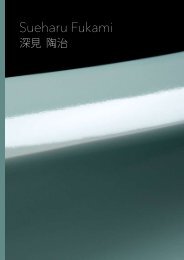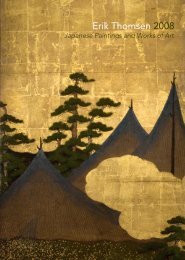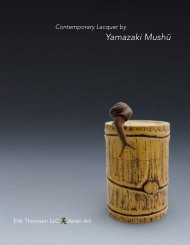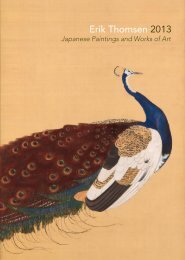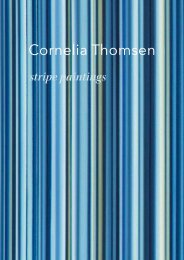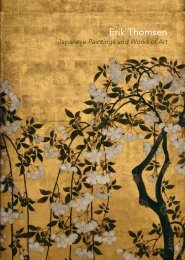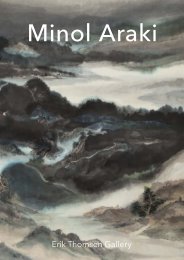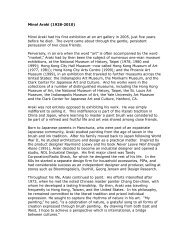View publication (pdf file 6.5 mb) - Erik Thomsen
View publication (pdf file 6.5 mb) - Erik Thomsen
View publication (pdf file 6.5 mb) - Erik Thomsen
- No tags were found...
You also want an ePaper? Increase the reach of your titles
YUMPU automatically turns print PDFs into web optimized ePapers that Google loves.
NotesNr. 1 Roosters and Chicken in a Ba<strong>mb</strong>oo Grove1 An early example of this communal reclusionappearing in both literature and art was the SevenSages of the Ba<strong>mb</strong>oo Grove ( 竹 林 七 賢 Zhulin qixian), a group of semi-legendary, like-minded sages,who created a small secluded community isolatedfrom the outside world. The group was composedof both historical and legendary figures said to havebeen active in the third century, A.D. They rejectedthe mundane world and gathered in a ba<strong>mb</strong>oogrove to drink wine, play musical instruments, andcarry on lofty conversation. For an early descriptionof the group, see Liu Yiqing 劉 義 慶 (403 – 44), Shishuo xin yu 『 世 說 新 語 』in Richard Mather, ed., ShihshuoHsin-yü: A new account of tales of the world.2nd ed. Ann Arbor: Center for Chinese Studies,University of Michigan, 2002, 235 – 6, 399 – 405.2 For a book-length discussion of such images, seeKendall Brown. The Politics of Reclusion: Paintingand Power in Momoyama Japan. Honolulu: Universityof Hawaii, 1997.3 See examples in Wakisaka Atsushi. Momoyamakōki no kachō: Kenrantaru taiga II. Series: Kachōgano sekai, vol. 4. Tokyo: Gakken, 1982, plates 22, 34,and 35.Nr. 2 Scenes from the Tales of Genji1 »Many years may pass, yet one thing will neverchange: that my heart is yours, for that I promiseyou by the Isle of Orange Trees« From chapter 51in the Genji. Murasaki Shikibu. The Tale of Genji.Royall Tyler, trans. 2 vols. New York: Viking, 2001,p. 1025. See illustrations of this scene, for example,Akiyama Ken and Eiichi Taguchi. Genji monogatari:Gōka »Genji-e« no sekai. Tokyo: Gakushū Kenkyūsha,1988, page 236.2 »Genji had the page girls go down and roll asnowball. Their charming figures and hair gleamedin the moonlight… the moon shone more and morebrightly through the marvelous stillness. She said:»Frozen into ice, water caught among the rockscan no longer flow, and it is the brilliant moon thatsoars through the sky.« Chapter 20, Tylor 373 – 4.Illustrated in Akiyama Ken and Eiichi Taguchi.Genji monogatari: Gōka »Genji-e« no sekai. Tokyo:Gakushū Kenkyūsha, 1988, pp. 96 – 7.3 Some artists depict this scene with the bridge,see Akiyama Ken and Eiichi Taguchi. Genji monogatari:Gōka »Genji-e« no sekai. Tokyo: GakushūKenkyūsha, 1988, p. 236.4 »The Pilgrimage to Sumiyoshi« Chapter nu<strong>mb</strong>er14, Murasaki Shikibu. The Tale of Genji. Royall Tyler,trans. 2 vols. New York: Viking, 2001, pp. 291– 2.Illustrated in, for example: Akiyama Ken and EiichiTaguchi. Genji monogatari: Gōka »Genji-e« no sekai.Tokyo: Gakushū Kenkyūsha, 1988, p. 79.5 See the thoughtful article by Melinda Takeuchion the cultural meaning of the Uji Bridge in KurodaTaizō, et al. Worlds Seen and Imagined: JapaneseScreens from the Idemitsu Museum of Arts. NewYork: The Asia Society Galleries, 1995.6 Miyuki Chapter 29. Murasaki Shikibu. The Tale ofGenji. Royall Tyler, trans. 2 vols. New York: Viking,2001, p. 499. Illustrated in Akiyama Ken and EiichiTaguchi. Genji monogatari: Gōka »Genji-e« no sekai.Tokyo: Gakushū Kenkyūsha, 1988, p. 143.7 Chapter 15, Murasaki Shikibu. The Tale of Genji.Royall Tyler, trans. 2 vols. New York: Viking, 2001,pp. 308 –10. Illustrated Akiyama Ken and EiichiTaguchi. Genji monogatari: Gōka »Genji-e« no sekai.Tokyo: Gakushū Kenkyūsha, 1988, pp. 80 – 3.Nr. 3 Scenes from the Great Eastern Road1 See: Constantine Vaporis. Breaking Barriers: Traveland the State in Early Modern Japan. Ca<strong>mb</strong>ridge,Mass.: Council on East Asian Studies, Harvard University,1994.2 Jippensha Ikku’s Hizakurige. An English translationby Thomas Satchell is the Shanks’ Mare: Being aTranslation of the Tokaido volumes of »Hizakurige«,Japan’s Great Comic Novel of Travel and Ribaldryby Ikku Jippensha (1765 –1831). Tokyo and Rutland,VT.: Charles E. Tuttle Company, 1960.3 The illustrations are not based on Hiroshige’sseries, although some stations might seem to beconnected, such as Okazaki and Ishiyakushi. Theseimages are instead based on the compositions inthe 1797 Tōkaidō meisho zue, which, as mentionedabove, served as a model for many of Hiroshige’sviews. See also footnote 5.4 This was already a famous place in Edo in themid-17th century. See the study by Hiraoka Naoki平 岡 直 樹 and Sasaki Kunihiro 佐 々 木 邦 博 »Edo meishokini miru 17-seiki nakagoro no Edo no meishono tokuchō« 『 江 戸 名 所 記 』に 見 る17 世 紀 中 頃 の 江 戸の 名 所 の 特 徴 . Shinshū Daigaku Nōgakubu Kiyō信 州 大 学 農 学 部 紀 要 38,1/2 (2002), pp. 37 – 445 A screen in the Berkeley East Asian Library (EastAsian Library call nu<strong>mb</strong>er: Byobu 2 SPEC-Map),which the university dates to the 17th century,shows the same mixture of sources. It may well bethat this was a separate tradition that focused onthe screen and hand scroll formats. The Berkeleyscreen and the present screen share a nu<strong>mb</strong>erof compositional features and it is possible thatthere is a connection of some kind betweenthe screens and their artists. For a image of theBerkeley screen, see the internet site: http://luna.davidrumsey.com:8380/luna/servlet/detail/RUMSEY~9~1~23272~50063:Tokaido-dochu-ezubyobu--verso---16Nr. 4 Peacock Pair by Cliffs1 See an example by Maruyama Ōkyo in: SasakiJōhei, Sasaki Masako, Osaka Shiritsu Bijutsukan大 阪 市 立 美 術 館 , 佐 々 木 丞 平 , 佐 々 木 正 子 , eds.Maruyama Ōkyo: Shaseiga sōzō e no chōsentokubetsuten 円 山 応 挙 : 写 生 画 創 造 への 挑 戦 特 別 展 .Tokyo: Mainichi Shinbunsha 每 日 新 聞 社 , 2003, pp.198 – 2012 For other biographical details, see Yui Kazuto油 井 一 人 . Nijusseiki bukko nihongaka jiten 20 世 紀物 故 日 本 画 家 事 典 . Tokyo: Bijutsu Nenkansha 美 術 年鑑 社 , 1998, p. 18. For the Kampo and the Araki familyof painters, see also Hitachi-shi Kyōdo Hakubutsukan日 立 市 郷 土 博 物 館 , ed. Kindai kachōga kō:Dokugakai, Araki Ichimon no keifu 近 代 花 鳥 画 考 ・読 画 会 、 荒 木 一 門 の 系 譜 . Hitachi 日 立 : Hitachi-shiKyōdo Hakubutsukan 日 立 市 郷 土 博 物 館 , 2000.Nr. 5 The Raven and the Peacock1 Taking the character »Hō 邦 « from his teacher.Kihō’s original name was Hiroaki 廣 精 , which appearsin the seal on the screen.2 They are still in museum storage. According tothe database of the University Art Museum, TokyoUniversity of the Arts, they are Summer Landscape夏 景 山 水 , hanging scroll, colors on silk, composedin 1890, 123.8 × 61.3 cm; Two Figures under a Pine,hanging scroll, colors on paper, 105.7 × 39.0 cm;and Summer Landscape, hanging scroll, colors onsilk, dated 1893, 80.8 × 155.8 cm. The latter is listedas his graduation work.3 Tsunoda Ryūsaku developed the Japanese collectionsat Colu<strong>mb</strong>ia Univeristy’s library and taughta nu<strong>mb</strong>er of pioneering courses at the university.Among his many students are figures such asDonald Keene, who has in turn been key in thedevelopment of Japanese studies in the UnitedStates. Among Tsunoda’s texts is the still-reprinted110 111



